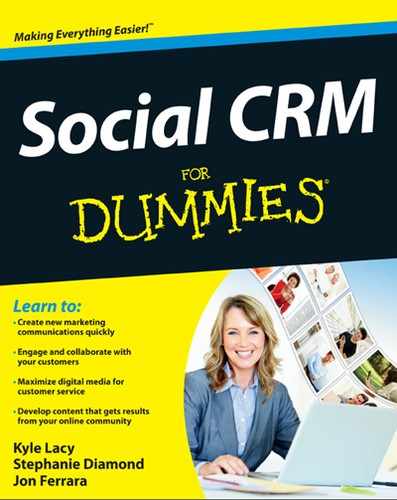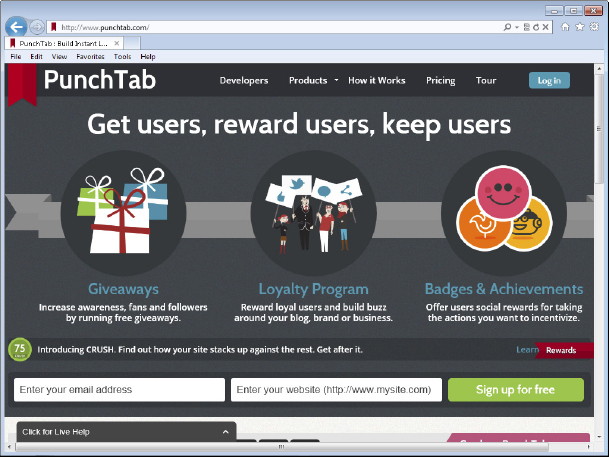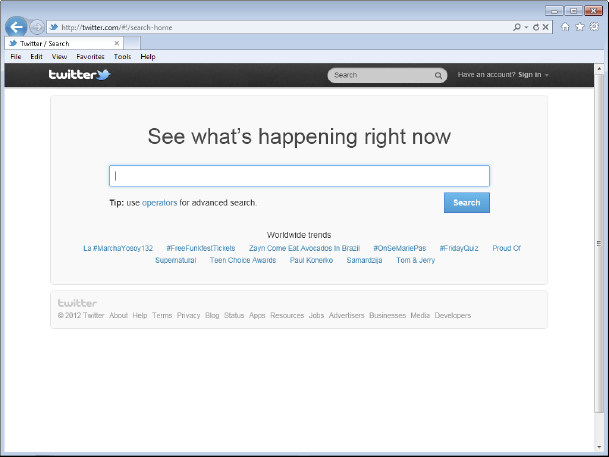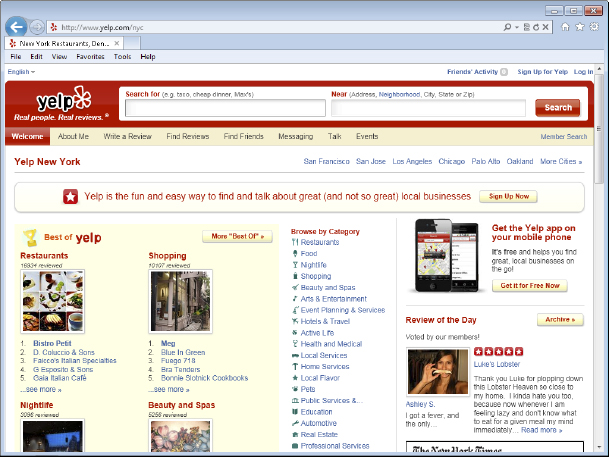Chapter 9
Building a Customer Loyalty and Advocacy Program
- Understanding how loyalty programs have evolved
- Discovering customer advocates
- Uncovering your customer's true behavior
- Communicating effectively with influencers
- Valuing your customers
Customer loyalty has always been a key factor in the health of any business. Without loyal customers, business owners would constantly be reinventing and changing their products to find ones that generate steady revenue.
If you think loyalty programs are old school, you might be envisioning programs like the trading stamps or S&H Green Stamps programs that started in the late 1890s and became very popular in the 1950s and '60s. These programs issued stamps with each purchase and a stamp book to paste them in.
When you filled up your book, you would take a trip to the local redemption center to pick out your prizes — mostly things like small appliances and toys for the kids. Families would enjoy these outings and come home with a small reward. This motivated them to keep coming back for more. For a while, this worked really well.
A variety of different programs gained and fell out of favor in the years that followed, but if you think loyalty programs aren't in favor now, consider this report from Jupiter Research: “Approximately 75 percent of consumers have at least one loyalty card and the number of people with two or more is estimated to be one-third of the shopping population.”
The nature of customer loyalty itself has changed with the advent of social networks. In the context of social CRM, loyalty programs are based not on products, but on relationships. Businesses need to recognize that loyalty is a two-way street, and pay attention to their customers in new ways. Customers want to be assured that their favorite businesses are listening to them and treating them with respect. This is quite a change from the advertising practices of the 1950s (highlighted in the popular Mad Men TV series) when all the messages were directed outward.
In the following sections, you learn why customer loyalty programs are valuable and how you can incorporate them into your social CRM.
Understanding Customer Loyalty
Customer loyalty programs are big business. The 2011 Colloquy Loyalty Census is available at
According to that report, Americans accumulate approximately $48 billion in rewards points and miles annually. However, one-third of those points are never redeemed. More people are participating in loyalty programs and getting less value from them than ever before.
With this in mind, part of understanding your customers is understanding the value they place on your loyalty program's rewards.
Evolving loyalty programs
To understand how to cultivate today's social customer, look at several of the factors that changed the face of loyalty programs in the 21st century. These factors include the following:
- Newer technologies help you engage your tech-savvy customers. Audience members (especially younger ones) want their loyalty programs to include the use of social media platforms and new technology like QR (Quick Response) codes. A QR code is a visual symbol that is embedded with link information. When a customer scans it with his smartphone reader, he's sent to the link. The link can contain advertising info, a coupon, or anything the marketer wants to show the user.
Think about how you can reward your tech-savvy customers who use smartphones and their increasingly advanced apps. You want to make sure that you speak to your customers where they hang out. Trying to create new customer behavior (such as asking customers to join a new network to get points) will never work. Try to provide a seamless experience. Some options include the following:
- Quick Response Code (QR code): QR codes can be a great way to engage customers. A QR code, such as the one shown in Figure 9-1, is a code that a smartphone user can scan with a reader installed on a smartphone or other mobile device. The smartphone then displays the web address associated with the code and gives users the option of opening that web address in their smartphone's web browser.
The code can link the customer to different interactions with your brand. For example, a code can take customers to a place on your site that has more detailed information about your latest promotion.
In addition to linking customers to information, you can link them to games or discounts, coupons, or other special promotions.
 When you use QR codes, remember that you have interested customers who want to engage with your brand, so treat them that way. Make sure to follow up through e-mail, direct mail, newsletters, mobile alerts, and social networks. Follow-ups like these prevent customers from drifting away after linking to you and demonstrate your commitment to earning customer loyalty. (For more information about QR codes, see QR Codes For Dummies Portable Edition, by Joe Waters.)
When you use QR codes, remember that you have interested customers who want to engage with your brand, so treat them that way. Make sure to follow up through e-mail, direct mail, newsletters, mobile alerts, and social networks. Follow-ups like these prevent customers from drifting away after linking to you and demonstrate your commitment to earning customer loyalty. (For more information about QR codes, see QR Codes For Dummies Portable Edition, by Joe Waters.)Figure 9-1: Scan the QR code with your smartphone's bar code reader.
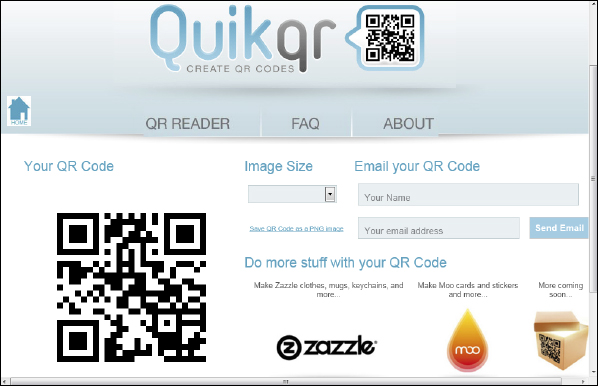
- Foursquare: Another possibility is to link to online networks that directly deliver reward points. One example of this type of network is Foursquare (https://foursquare.com), shown in Figure 9-2. This geolocation app uses a mobile phone's GPS locator to display offers and information for nearby businesses.
Foursquare is a social network that encourages your customers to visit your physical location. When they check in on Foursquare, they're rewarded with points or badges. They can also interact with other like-minded customers by checking the online Foursquare stream. In addition, Foursquare links to Facebook, so customers can interact with friends as well. For more on Foursquare and other social media platforms, see Social Media Marketing For Dummies,” by Shiv Singh and Stephanie Diamond.
- PunchTab: Provides an established framework that allows your customers to participate in rewards programs, as mentioned in Figure 9-3. This can work well for smaller companies that can't afford to create a program from scratch. The data you collect here can be plugged back into your CRM. Go to www.punchtab.com for more information.
- Quick Response Code (QR code): QR codes can be a great way to engage customers. A QR code, such as the one shown in Figure 9-1, is a code that a smartphone user can scan with a reader installed on a smartphone or other mobile device. The smartphone then displays the web address associated with the code and gives users the option of opening that web address in their smartphone's web browser.
Figure 9-2: Foursquare home page.

Figure 9-3: PunchTab home page.
- Customers want companies to be socially responsible. We all know that the Internet has dramatically changed the world. As author Thomas L. Friedman says in his book of the same name, “The world is flat.” This means that people can instantly see what's happening around the world. Moreover, they can interact with the people to whom it's happening.
For example, it's widely believed that Twitter influenced the rise of the Arab Spring in 2010 by allowing protestors to tell and show the world what was happening. For reasons like this, the social customer wants to see companies pulling their weight in society.
According to the 2010 Consumer New Media Study by Cone Communications, 85 percent of respondents said they would switch brands, and 73 percent say they would try a new brand if a company demonstrates strong prosociety practices.
Burt's Bees, a beauty product maker headquartered in North Carolina, is a great example of a company that's benefitting from its strategy to give back. Burt's Bees employees teamed up with Habitat for Humanity to provide workers to help build ecofriendly homes.
This is only one of the programs in which they participate, as shown in Figure 9-4. This has proven a winning strategy for them. Burt's Bees was purchased by Clorox in 2007 for its GreenWorks line of products and their revenues continued to soar — in 2009, their revenue topped $250 million. Their generosity is widely known and appreciated by their customers, thus building loyalty.
- CRM tools have evolved to provide valuable customer data that can impact customer loyalty. CRM tools have dramatically improved as more sophisticated computing becomes available. Previously, contact management tools didn't provide the kind of data you really needed to impact your business. The computing capability just wasn't available. Now even a free tool like Google Analytics can help a business owner see her customer's online purchase profile.
A CRM system is valuable because it integrates different types of data about the customer from a variety of business functions. Last century, a business owner might have used a PC-based program like Microsoft Outlook to do contact management. He would diligently add names to the contact manager and try to personally collect information about each customer. His system was only as good as the time he put into it.
Once he graduated from this rudimentary software, he would've used something like PC-based GoldMine (a company previously owned by author Jon Ferrara). GoldMine was very advanced because it integrated sales data into the contact management system. Today's CRMs include data collected from all business functions.
Figure 9-4: Burt's Bees programs that give back to the community.
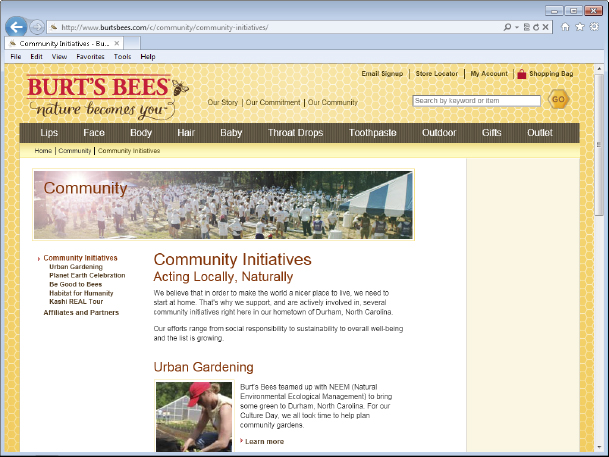
- Customer kudos and complaints can reach thousands, even millions, of people at lightning speed. The effect of the customer's advocacy is magnified. Online customer reviews are among the tools that have changed the balance of power between manufacturers and customers. In the past when customers were disgruntled with a product, they would tell their small circle of friends. That was bad for business, but the effects were hard to quantify. Now anyone with a computer can be heard loud and clear by submitting an online review of a product. (See the upcoming section “Hearing what customers are saying” for specific online sites where customers vent.)
Discovering why loyalty programs matter
Fred Reichheld — author of several seminal books on loyalty, including The Ultimate Question 2.0: How Net Promoter Companies Thrive in a Customer-Driven World — reports that “a 5 percent improvement in customer retention rates will yield between a 25 to 100 percent increase in profits.” Wow, that's a statistic you can't afford to ignore! The key is to build a program that's highly relevant to the customers you serve.
Loyalty data is one of your company's best assets, no matter its size. By collecting data about your loyal customers, you can understand such things as the following:
- Customer trends in real time
- Promotions that impact your loyal customers most
- How to increase conversion rates (the rate at which a lead is turned into a customer) among new customers based on your experience with loyalty programs
How do companies view the value of loyalty programs today? According to a survey by SAS and Loyalty 360, here are the top goals of loyalty programs:
- To increase customer spending
- To reduce customer loss
- To turn customers into advocates
These are difficult goals to pull off. The ability to achieve them is enhanced by the fact that you can reach these customers directly on social media platforms. Your CRM can accumulate the data you need to make a connection with your customer meaningful.
After you're convinced your business needs a loyalty program, remember that your customer needs a reason to join and participate. You must create a reason for your customer to stay faithful. You want customers to value their incentives and engagement to the point that they wouldn't think of buying elsewhere.
 You should also be aware that loyalty programs can have a negative effect. The stakes are higher. They raise customer expectations about the type and quality of the service you offer. If you anger a customer in a loyalty program, you're likely to lose that person forever.
You should also be aware that loyalty programs can have a negative effect. The stakes are higher. They raise customer expectations about the type and quality of the service you offer. If you anger a customer in a loyalty program, you're likely to lose that person forever.
The following two sections explore how you can enroll and retain customers in your loyalty program.
Introducing types of loyalty programs
You've probably heard the adage before: Finding a new customer costs more than selling to one you already have. Loyal customers are hard to find and hard to keep. Customers who strictly shop on price will go from company to company to find the best bargain. They will almost never become a loyal customer. If they can find the item cheaper somewhere else, they will grab it.
What characterizes loyal customers? They are the ones who are willing to pay a bit more or stay with you no matter what. Table 9-1 shows some potential ways to inspire customer loyalty with different types of loyalty programs. After customers join a loyalty program like those listed here, you can communicate with them via social media. For example, you could devote a Facebook page to loyalists in the program.
Table 9-1 Types of Loyalty Programs
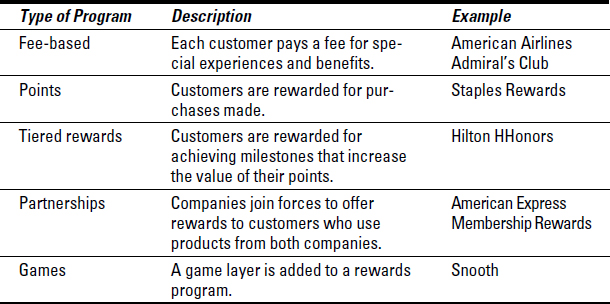
Making your most valuable customers feel loved
Everyone is vying for your customers' attention. Online ads, videos, points programs, and free samples are available everywhere. If you can think of ways to create a memorable experience for your customer, the rewards will be great. If you can do something extraordinary for a customer, you will cut through the clutter.
A great example of this is the experience Peter Shankman of HARO (Help a Reporter Out) www.helpareporter.com had with ’Morton's The Steakhouse in Hackensack, NJ. Shankman reports that in August 2011 he was on a business trip that would end back at his home airport at a late hour. He was a regular customer of ’Morton's across the country when he traveled. He hadn't eaten much that day, so while on his way home, food was on his mind.
As a joke, he tweeted, “Hey @Mortons – can you meet me at Newark airport with a porterhouse when I land in two hours? K, thanks. :)” Much to his amazement when he landed, a Morton's employee in a tuxedo was waiting for him with a bag that included a 24-ounce porterhouse steak. Needless to say, he experienced shock and amazement. He tweeted a picture of himself with the employee and expressed his uncontrolled joy. Even his dog was going to eat steak that night.
The great thing about this for Morton's was that not only did Shankman tweet his amazement, but his follower's on Twitter went wild with tweets about it. (He had over 100,000 Twitter followers at the time.) In addition, Morton's got free TV coverage and great PR. All for the price of a steak dinner and a trip to the Newark airport.
In retrospect, you can look at that experience and see how Morton's would benefit, but remember, they took quick action in real time. They didn't have time to plan and execute over several days. They had two hours.
What can you learn from this? Think about the following when you're trying to develop incredible experiences that create customers for life:
- Follow your social networks in real time as often as possible. Morton's had an employee watching its Twitter stream for mentions of their brand. If they didn't see the tweet right away, the opportunity would've been lost.
- Take bold action to stand out. The rewards are great if you're willing to break out of the “business as usual” category. A unique story often catches the eye of the media, as it did in this case.
- Think about the visual potential of the experience. Morton's sent an employee in a tuxedo to present the steak, as shown in Figure 9-5. When Shankman took the inevitable picture and put it on Twitter, it made a huge impression on customers (as well as potential customers).
Figure 9-5: Peter Shankman receives his complimentary dinner from a Morton's employee in a tuxedo.

- Give your employees the authority to make customers happy. If your employees have to request permission for every unique experience they want to provide, the spontaneity will be lost. Let your employees know that you value their deep commitment to customers and reward them for it. If you don't walk the walk, they will be afraid to take the initiative.
As we can see from this example, there are many ways to reward loyal customers. The type of loyalty program you employ should depend on the types of rewards that customers find valuable. For example, in Table 9-1, loyalists are rewarded with perks that give them extra value. In the Twitter example, a loyalist is rewarded for mentioning a business on Twitter. The publicity of that tweet had great value to the company as well as the tweeter.
Understanding the Value of Loyal Advocates and Social Influencers
Today's customers demand to be heard. Listening to them and reacting to their requests can build loyalty not only among the respondents, but also among those who see that response. That's one of the true benefits of responding to your customers on a social platform. Others can see and appreciate your engagement.
The loyal advocate is the customer who will aggressively share your message with others. To understand the value a loyal advocate brings to a business, we need to analyze the difference between the social influencer and the true advocate.
Influencing the influencer
Social influencers play a key role in your ability to reach customers. A social influencer is a trusted person with a large faithful following. A social influencer's endorsement of your product or service can help your business acquire new customers. Your loyal advocate uses word of mouth to reach her circle of trusted friends and has the potential to reach a large number of people you might never reach. For more on influence, see Chapter 7.
To find the people who influence your customers, you can look in several places. Here are some data sources to consider monitoring to find influencers. If your CRM doesn't collect social platform data, you may need to integrate it into your data:
- Traffic sources: If you see that you're getting traffic from specific websites, you should investigate. Websites with high referrals to your website may already be mentioning your company or products.
- Social media sites: Use the search tools on Twitter, Facebook, Pinterest, LinkedIn, and Google+ to see who has major influence in your industry. Each of these platforms has a search function that allows you to hone in on your topic of interest. General feeds are useful, but you want to get directly to the people who are interested in you. To get started, try the search function on Twitter, which is in the upper-right corner of the home screen, as shown in Figure 9-6.
For example, if you provide financial consultation services, you might begin by searching broadly, with the term financial information. In the search results, you'll see the following:
- Questions that people are asking
- Specific influencers who are providing information
- Links to sites that provide services
Using that information, you can learn a lot about what customers want to know and who offers consultations.
Figure 9-6: Twitter search function.
- Forums and blogs: These tools provide a great way to find influencers. If you find forums on topics that relate to your business, you'll quickly be able to see who is leading the discussions. To get started, check out BoardReader (http://boardreader.com). BoardReader is an online search tool that allows you to search across forums and boards to find the ones that interest you, rather than having to individually search them. Begin to participate, and once people know you, they'll be interested in your message. Don't attempt any heavy sales pitch.
Understanding the needs of the loyal advocate
The true advocate is the customer who loves your brand and lets his family and friends know it. How can you spot a true advocate? Fred Reichheld, in his book The Ultimate Question 2.0: How Net Promoter Companies Thrive in a Customer-Driven World, thinks he knows. The ultimate question for him is, “How likely is it that you would recommend our company to a friend or colleague?” If your customer won't recommend your company to her trusted inner circle, she isn't a true advocate. (This kind of advocate is also commonly called a customer evangelist.)
To encourage and cultivate customer evangelists, examine what makes those customers respond to your brand in a way that others don't. Do they look to you to provide information about how to use products like yours? For example, if you sell wedding dresses, do potential customer evangelists look to you because you provide great information and advice about how to host a cost-effective wedding? When you solve customers' problems, do you make them feel special and valued by your company? With the downturn in the economy, customers are looking for more custom shopping experiences. One way to do this is to team up with like-minded companies who can make your sales experience unique.
A great example of this is the iOS app created by a company called SnapShop (www.snapshopinc.com), as shown in Figure 9-7. From an iPhone, iPad, or iPod touch, a furniture shopper can see how furniture (including such brands as IKEA, Pier 1 Imports, and Horchow) looks in his own room. Here's how it works: As the app user, you snap a photo of your room and place the virtual furniture in it. If it looks good, you can buy it on the site directly from the brand.
Think about how you can make the purchase of your products a unique experience that will keep your customer coming back.
Figure 9-7: SnapShop home page.
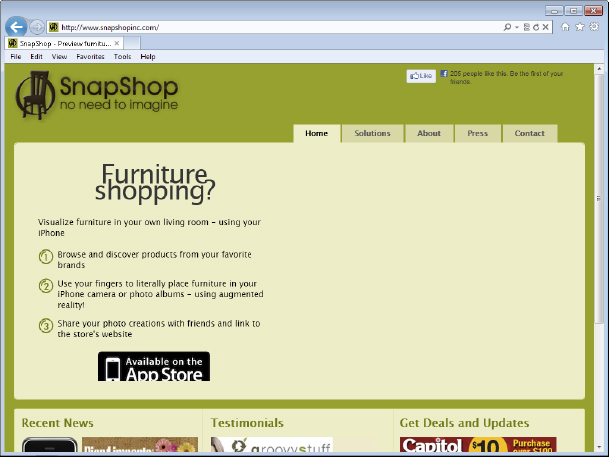
Enhancing Customer Loyalty and Advocacy
To enhance customer loyalty and advocacy with social customers, you should attempt to provide a more personal experience. To do that, you should be right at the source of customer feedback, watching tweets as they fly by and providing quality customer service in real time whenever possible. (See more about customer service in Chapter 10.) For example, you can set up a Twitter account specifically to receive customer service questions, like United Parcel Service (UPS) does at http://twitter.com/#!/upshelp.
Utilizing customer touch points
To show customers that you're available to hear them, you want to be present at all your customer touch points — the channels where the brand interacts directly with customers. These touch points include e-mails, register checkouts, Twitter, Facebook, and so on. Major retailer Bloomingdale's recently created an innovative loyalty program at checkout called Loyallist, as shown in Figure 9-8, that makes excellent use of customer touch points.
Figure 9-8: The Loyallist program at Bloomingdale's.
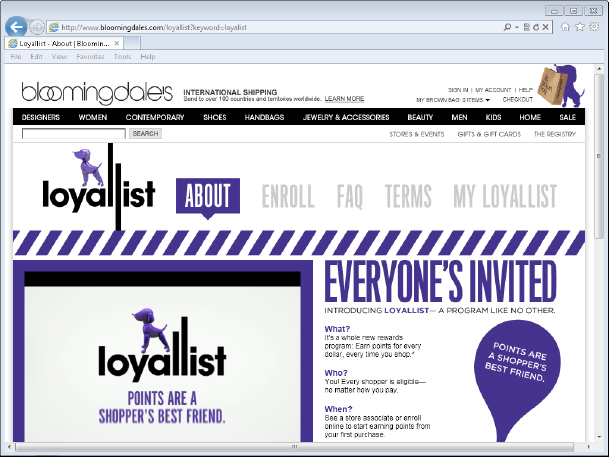
Typically, high-end retail loyalty programs require customers to sign up for a store credit card. This confers exclusivity and benefits the retailer by having the customer pay the additional carrying charges. But Bloomingdale's cleverly sets aside this requirement. Their program allows all shoppers to participate by issuing them a Bloomingdale's loyalty card linked to their phone number.
If a shopper doesn't use a store credit card when he makes a purchase, he can simply offer his phone number or physical loyalty card at checkout. This is especially useful to Bloomingdale's because it allows the retailer to collect loyalty shopper data and issue rewards for all its shoppers, not just the ones who have a store credit card.
In addition, Bloomingdale's can utilize several of its touch points by allowing shoppers to accrue loyalty points whether they're shopping online, in a store, or at their outlets. Their loyalty slogan “Every shopper, every day” helps them get everyone into the program. In return, shoppers get one point for every dollar they spend and two points if they use their store credit card. A customer who accrues 5,000 points also receives a $25 reward card in addition to the rewards per point. Loyalists receive monthly e-mails that detail new products and discounts.
In your own business, think about how you can use your customer touch points to create a unique program that connects with your customers at more places than the point of purchase. Do away with any barriers that might be in place.
Hearing what customers are saying
Before the Internet, retailers never had to deal with was customers from across the globe sharing all manner of opinions with fellow customers in easy-to-access public forums with no permission required. For example, the web abounds with stories about restaurants that have treated their customers with disrespect or bad service. Pre-Internet, the complaints were only heard via word of mouth by local customers. Now customers get the benefit of hearing the opinion of customers they don't know personally.
The types of products and services you offer dictate where your products are reviewed. Here are some places where you'll find online reviews:
- Epinions: This is a mature site that hosts reviews on a variety of topics. Their tagline “Unbiased reviews from real people” ensures that reviewers are encouraged to give the unvarnished truth. (http://epinions.com)
- Yelp: This site hosts product and service reviews in various business categories at http://yelp.com, shown in Figure 9-9. Yelp has over 54 million unique page views per month and categorizes its data by location and type.
- Amazon.com: This site's review database is actually the largest online opinion website because every product it sells has a space for reviews. Before purchasing, customers pour over what others have to say.
- TripAdvisor: This site provides extensive information and reviews about vacation spots, hotels, and restaurants. A great addition is the abundance of photos.
- Urbanspoon: This site is great if you're looking for menus and reviews for local restaurants. If you're in the restaurant industry, check here to find out what customers are saying about your business.
One general finding about customer reviews is that one or even a few negative reviews won't turn a customer off. Most people know that you can't please everyone and realize that some negative comments attached to a product listing simply means that real people are sharing their opinions.
Don't be afraid to let bad reviews stand, even when you've tried your best to resolve them. If potential customers sense that you're censoring your reviews, they'll leave quickly, never to return. Responding to negative reviews gives you the opportunity to demonstrate that you want to engage unhappy customers and fix things.
It's also a good idea to provide a link to these reviews from your site instead of trying to host the reviews yourself. You'll get more exposure on a site with multiple restaurants. In searching the database, someone may run across a review of your restaurant and be inspired to try it.
So how should you deal with feedback received in online reviews? Consider the following tips:
- Stay positive when you react to negative reviews. Don't get drawn into petty name-calling. It's a real turn-off to customers. Even if you are right, you need to maintain a respectful tone. Remember that you're speaking to the audience at large, not just one customer.
- Look at the bigger picture. Each review, whether positive or negative, is an opportunity for you to educate your audience about you. If you add tips, you'll have used the review as another social media channel. For example, if applicable, you could say something like, “Next time, try our deserts — the chocolate lava cake is very popular among chocoholics.”
- Be authentic. Answer reviews like a real person would. If you use company-speak, you'll make reviewers feel like they aren't important.
Delivering relevant content
Key to the success of any loyalty program is the use of relevant content that provides real value to the customer. The term relevant content refers to such things as product suggestions and tips for using the products and discounts. This is where your CRM data becomes crucial. To understand how content impacts your loyalty programs, you need to consider the following two factors:
- Internal data collected about your customers: Data from your CRM system will obviously point the way for you to create relevant content. For example, by looking at historical data about your customers, you can see what types of articles are read most often on your website. Armed with this information, you can increase the number of those articles and tie that information back to promotions and discounts.
For example, if you find that articles and blog posts with the best time-saving tips for using your product, for instance, are popular, you can make sure to include your promotion links in those specific articles and track their success. The key is to constantly monitor the data to see what kinds of changes occur over time. Consider each promotion an experiment that can be improved over time.
- External data about the environment in which the customer lives: It's easy to think that you really know your customer, based on the internal data you collect. You see your customers' shopping habits and draw conclusions, but it's also important to include data about such things as the economy, political issues, and popular culture memes.
As we know, the economy has been challenging for several years. Katherine Field Boccaccio of Drug Store News reported on a study released by MarketTools in April 2011. She found that grocery shopping habits had changed in the previous six months. It's unclear why specifically shoppers had shifted behavior at that time, but perhaps above all else, shoppers were seeking value.
According to the study, respondents reported the following:
- 80 percent buy with coupons.
- 62 percent buy store brands instead of name brands.
- 62 percent use store loyalty cards that offer discounts.
- 58 percent buy items only when they're on sale.
- 43 percent buy more large-sized products to save money on grocery bills.
Armed with information like this, you can create content that's highly relevant to your customers. Obviously things like loyalty cards and coupons might already be in your arsenal. But how about a promotion of store brands or bulk purchases?
This is just one possible example, but it gives you a direction upon which you can base small content experiments. The standard type of content that you create about products and services will always be in the pipeline. This type of specific data can help you impact your customer in real time.
Using gamification to encourage loyal customers
Gamification is a concept that's grabbing the interest of customers and loyalty program managers alike. It refers to the application of game dynamics to business functions to encourage customer engagement. According to a Gartner report, “by 2014, a gamified service for consumer goods marketing and customer retention will become as important as Facebook, eBay, or Amazon, and more than 70 percent of Global 2000 organizations will have at least one gamified application.”
People are playing online games with others, buying virtual goods, and looking for the next hot game app in record numbers. Marketers are jumping on the bandwagon hoping that they can encourage loyalty by using this new-found interest in games.
The concept of using games behaviors in loyalty programs isn't really new. Some variation on the customer winning points has always been part of the process. What's new is the nature of social gaming. The technology goes far beyond old-style loyalty programs.
The benefit of applying gamification to business apps includes the following:
- A fully engaged and loyal customer
- The opportunity to solicit product ideas and feedback
- The potential for messaging associated with a game to go viral
- The opportunity to encourage employees to access training that isn't only fun, but educational
When you think of gamers, you may have some misconceptions about their profile and the value of social games for your business:
- Misconception: The average gamer is young, male and always online.
If your customer doesn't fit this profile, you've probably discarded the idea of using games in your CRM, but don't be misled. According to a study by the Information Services Group in 2011 and several corroborative studies, the average social gamer is a 43-year-old woman. Does this fit into your customer demographic? It's likely that your customers are interested in games that provide tangible rewards.
- Misconception: Playing games online has no real value.
Game designer Jane McGonigal has been pursuing the idea that social game behavior has value and should be used to help solve societal or personal problems. She created a game called SuperBetter (www.superbetter.com), shown in Figure 9-10, to help herself overcome the effects of a head injury, and now people around the world use this game to improve their own health.
From her studies, McGonigal found that when we play games we are
- Fiercely optimistic
- More resilient and prone to persevere
- Likely to build strong bonds with those we play games with
- More cooperative
- Prone to feel very productive
Her goal is to marshal this behavior for good causes and to encourage others to do the same. With this in mind, think about the kinds of games you can create for your customers. There really is no limit to the type of business that could benefit from a loyalty game.
One fun example of a loyalty game is Snooth Wine Rack (http://snooth.com/wine-rack). Snooth is the world's largest wine site. Its mission is to simplify “how people select, learn about and purchase their favorite wines.” The game lets you select wines and compete to become an expert. The home page is shown in Figure 9-11. As you learn about Snooth's selection, you can price wines and purchase them from vendors through the Snooth website.
This game is popular because it hits the mark in three important ways: It's entertaining, educational, and easy to use. Those are three criteria that most good games should have.
